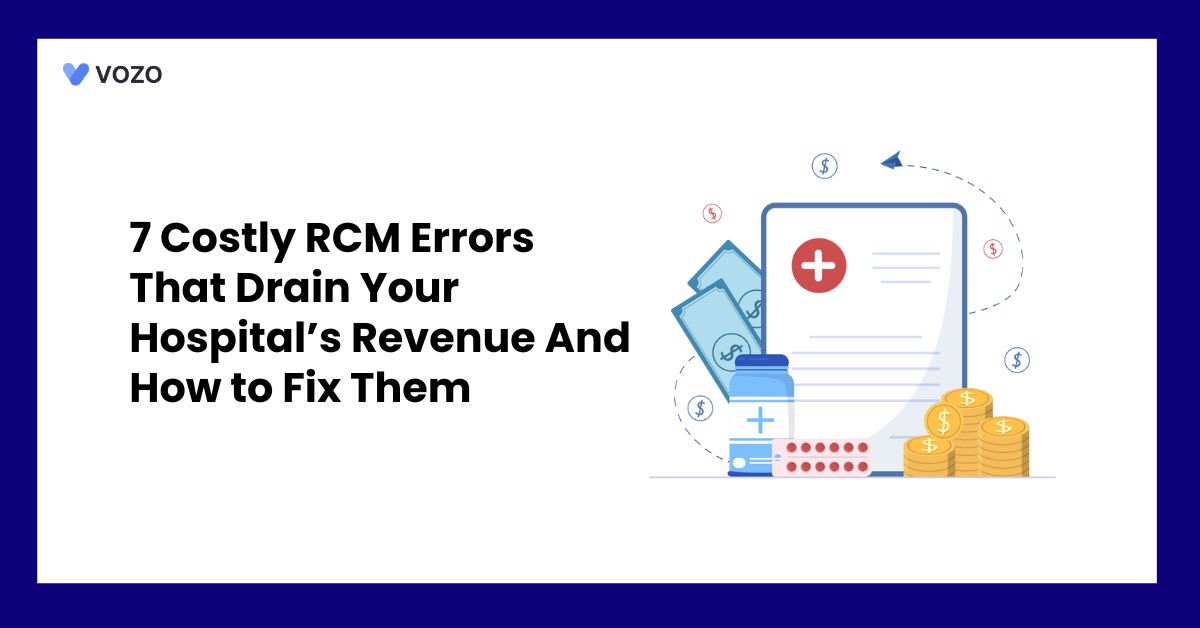7 Costly RCM Errors That Drain Your Hospital’s Revenue And How to Fix Them
Revenue cycle management is a critical component of every healthcare organization. Even modern hospitals frequently lose considerable money owing to preventable mistakes in claims processing, documentation, and billing operations. Reducing these mistakes is not only a best practice, but also necessary for financial stability and development for reimbursements and more patient financial responsibility.
In this blog, you’ll know the 7 most common and costly RCM errors that hospitals make, and steps to fix them to make your practice financially stable.
7 Common RCM Errors and How to Correct Them
1. Inaccurate Patient Registration and Data Collection
One of the most common RCM mistakes is gathering wrong or incomplete patient information during registration, such as misspelled names, incorrect dates of birth, invalid insurance IDs, and out-of-date contact information. Every error or omission can cause claim rejections, resulting in claim denials, delays, and revenue losses.
- Rejection of claims due to nonclinical mistakes.
- Manual rework increases the administrative workload.
- Patients are unsatisfied due to a billing misunderstanding.
How To Fix It
- Implement real-time validation during registration, like computerized forms that identify errors and demand necessary fields before submission.
- Train front-line employees and ensure that front-desk staff understand the frequent errors in name format, insurance information, demographics, and double-check important fields.
- Conduct routine audits, such as weekly/monthly spot inspections of registered data, to help detect systemic flaws early.
- Re-verify data at check-in, a second insurance check upon arrival detects changes and minimizes errors.
2. Fail to Verify Insurance Eligibility and Pre-Authorization
Submitting services for patients without confirming coverage or obtaining appropriate pre-authorizations leads to claim rejections, especially for complex or costly treatments.
- Increased claim denials and rejections.
- Decreased compensation for out-of-network services.
- Unexpected costs irritate patients.
How To Fix It
- Conduct real-time eligibility checks and integrate automatic, electronic verification before appointments and again at check-in to assure current coverage.
- Maintain a detailed table of procedures that require authorization. Keep a track of approvals and deadlines for pre-authorization.
- Educate staff about payer rules and assign accountability. Keep a centralized track of permission status and expiration dates.
- Proactive follow-up identifies services that require permission and communicates with patients if coverage gaps develop.
3. Coding Errors or Missing Codes
Mistakes in CPT/ICD coding, like wrong codes, missing modifiers (e.g., for bilateral operations), undercoding, or outdated code use, are the major causes for rejections, decreased payments, and audits.
- Rejected or underpaid claim
- Potential compliance fines
- Need for costly auditing and appeals
How To Fix It
- Hire certified developers and keep staff updated with CME training and periodic code upgrades.
- Use modern tools and approved software to automatically check code validity and apply modifications.
- Perform frequent internal audits and review charts to determine accuracy and fundamental reasons.
- Feedback and retraining help to identify frequent mistakes with programmers and retrain those who require improvement.
Related: Are You Making These Common Medical Billing Mistakes? Fix Them In 2025
4. Inefficient or Delayed Claims Submission
Manual, delayed, and missing claims from patient interactions lead to considerable leakage. Unbilled claims services are commonly missed.
- Missed revenue from finished services
- Delayed cash flow
- Staff frustration with pursuing records
How To Fix It
- Automate tracking systems that utilize a practice management system that identifies unbilled encounters and aging claims.
- Daily reporting helps to deliver unbilled “charge capture” reports to the respective departments every morning.
- Assign teams and ownership to monitor unbilled claims and close registration, coding, and invoicing gaps.
- Establish and monitor service-level agreements, such as “all claims submitted within 48 hours of service.”
5. Poor Denial Management
High denial rates often range from 9-15% of claims, and a failure to appeal or fix them wastes money and effort. Studies reveal that up to 60% of rejections are not resubmitted.
- Millions in lost reimbursements
- Aging AR tiles, wasted staff time on avoidable denials
How To Fix It
- Denial-prevention techniques use pre-submission editing tools to identify problems before delivering claims.
- Establish a dedicated denial team that is skilled in identifying patterns, evaluating reasons for rejections, and making timely appeals.
- Track denial metrics by denial trends by payer, service, and reason. Identify spikes via dashboards and reports.
- Close the loop, feed insights back to point-of-care staff to prevent recurring errors.
6. Poor Patient Balance Management
Incomplete collection of copays, deductibles, and coinsurance at the time of service causes aging receivables, substantial write-offs, and low collection rates.
- Reduced income from patient accountability
- Increased A/R and cash flow difficulties
- Frustration with surprise billing
How To Fix It
- Transparent financial conversations should be communicated, including cost estimates and responsibilities, before the service.
- Use point-of-care payment technologies that accept different payment options at check-in and checkout; employ self-service kiosks or online portals.
- Automatically generate reminders and statements to remind patients of balances and due dates, and send SMS or emails.
- Offer flexible plans and collections that provide payment arrangements and escalation to collection agencies for persistent debt.
7. Lack of KPI Tracking
A divided revenue cycle where registration, coding, billing, denial management, and collections function independently leads to inefficiencies, lost coordination opportunities, and mistakes.
Ignoring key performance indicators such as days in accounts receivable, denial rate, and clean claim percentage conceals issues until they become serious.
- Fragmented processes result in rework.
- Declining financial performance over time.
- Difficulty with continuous process improvement
How To Fix It
- Create a Revenue Integrity Committee with stakeholders from each department that will meet frequently.
- Centralized RCM leadership and appoint a Chief Revenue Officer or Director to oversee the entire process and identify bottlenecks.
- Track parameters such as claim submission time, rejection rates, appeals success rate, days in A/R, net collection rate, and so on.
- Quarterly training on policy updates, coding changes, and payer needs is part of the ongoing training for all department employees.
Related: 10 Best Ways to Improve Medical Billing Efficiency
Vozo Revenue Management Cycle Service for your Medical Practice
At Vozo, we understand your struggle in navigating through all the revenue cycle processes, such as regulations, medical coding, and reimbursements.
That’s why we bring the best cutting-edge service to optimize your revenue cycle management from start to finish. Here’s how Vozo can help you transform your practice’s financial performance.
- Automated tools for error-free coding and faster reimbursements
- User-friendly billing to keep patients satisfied and payments flowing
- Robust data security and compliance protocols to protect your practice
- Detailed reporting and analytics for smarter business decisions
- Solutions that grow alongside your evolving needs
With Vozo RCM service, you can reduce the headaches associated with revenue cycle management and focus on what matters the most – quality patient healthcare delivery.
“Partner with Vozo RCM Service and unlock the full potential of your healthcare practice and maximize its revenue”.
About the author

With more than 4 years of experience in the dynamic healthcare technology landscape, Sid specializes in crafting compelling content on topics including EHR/EMR, patient portals, healthcare automation, remote patient monitoring, and health information exchange. His expertise lies in translating cutting-edge innovations and intricate topics into engaging narratives that resonate with diverse audiences.













